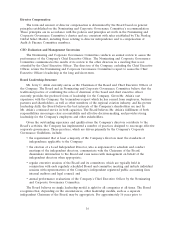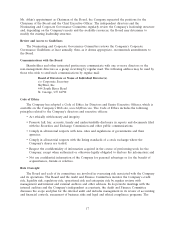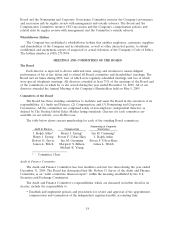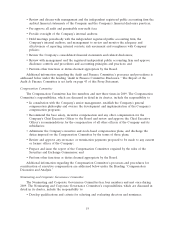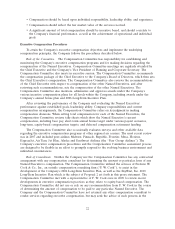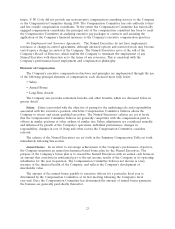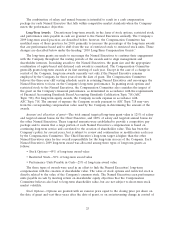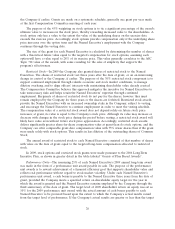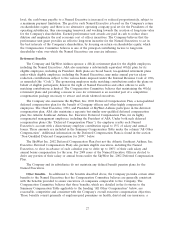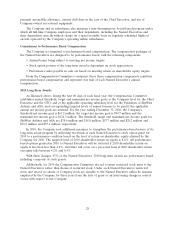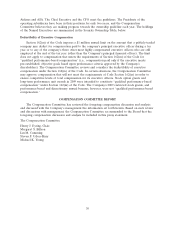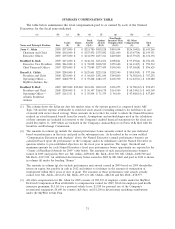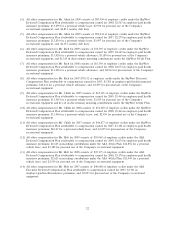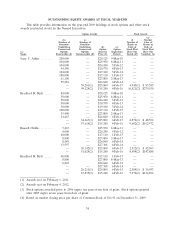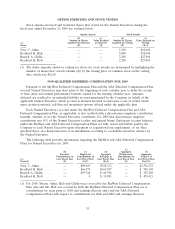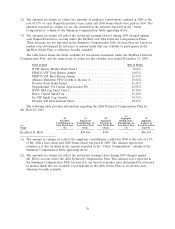SkyWest Airlines 2009 Annual Report Download - page 132
Download and view the complete annual report
Please find page 132 of the 2009 SkyWest Airlines annual report below. You can navigate through the pages in the report by either clicking on the pages listed below, or by using the keyword search tool below to find specific information within the annual report.the Company if earlier. Grants are made on a systematic schedule, generally one grant per year made
at the first Compensation Committee meeting of each year.
The purpose of the 45% weighting on stock options is to tie a significant percentage of the award’s
ultimate value to increases in the stock price, thereby rewarding increased value to the shareholders. A
stock option only has a value to the extent the value of the underlying shares on the exercise date
exceeds the exercise price. Accordingly, stock options provide compensation only if the underlying share
price increases over the option term and the Named Executive’s employment with the Company
continues through the vesting date.
The size of the grant for each Named Executive is calculated by determining the number of shares
with a theoretical future value equal to the targeted compensation for stock options, assuming each
option will have a value equal to 28% of its exercise price. This value generally correlates to the ASC
Topic 718 value of the awards, with some rounding for the sake of simplicity that supports the
program’s effectiveness.
Restricted Stock—In 2009 the Company also granted shares of restricted stock to the Named
Executives. The shares of restricted stock vest three years after the date of grant, or on an intervening
change in control or the Company, if earlier. The purpose of the 30% restricted stock component is to
support continued employment through volatile economic and stock market conditions, to manage
dilution overhang, and to align officers’ interests with maintaining shareholder value already created.
The Compensation Committee believes this approach mitigates the incentive for Named Executives to
take unnecessary risks and helps retain the Named Executives’ expertise through continued
employment. Recipients of shares of restricted stock do not pay for the shares; however they must
remain employed by the Company for three years or the shares are forfeited. Restricted stock awards
provide the Named Executives with an increased ownership stake in the Company, subject to vesting,
and encourage the Named Executive to continue employment in order to meet the vesting schedule.
The compensation value of a restricted stock award does not depend solely on future stock price
increases; at grant, its value is equal to the Company’s stock price. Although its value may increase or
decrease with changes in the stock price during the period before vesting, a restricted stock award will
likely have value even without future stock price appreciation. Accordingly, restricted stock awards
deliver significantly greater share-for-share compensation value at grant than do stock options, and the
Company can offer comparable grant date compensation value with 75% fewer shares than if the grant
were made solely with stock options. This results in less dilution of the outstanding shares of Common
Stock.
The annual award of restricted stock to each Named Executive consisted of that number of shares
with value on the date of grant equal to the targeted long-term compensation allocated to restricted
stock.
In 2009, stock options and restricted stock grants were made pursuant to the 2006 Long-Term
Incentive Plan, as shown in greater detail in the table labeled ‘‘Grants of Plan Based Awards’’.
Performance Units—The remaining 25% of each Named Executive’s 2009 annual long-term award
was made in the form of a performance unit award payable in cash. The purpose of the performance
unit awards is to reward achievement of a financial efficiency goal that supports shareholder value and
reflects real performance without regard to stock market volatility. Under each Named Executive’s
performance unit award, a cash bonus is payable to the Named Executive three years from the date of
grant, provided the Company meets a specified return on shareholder equity target for the year in
which the award is granted and the Named Executive remains employed by the Company through the
third anniversary of the date of grant. The target level of 2009 shareholder return on equity was set as
10% for the 2009 performance unit award, with the actual amount of cash bonus payable to each
Named Executive to be prorated based upon the extent to which the Company’s actual results varied
from the target level of performance. If the Company’s actual results are greater or less than the target
26


